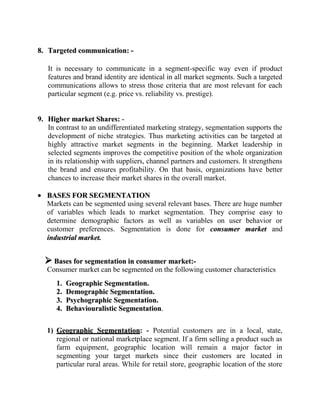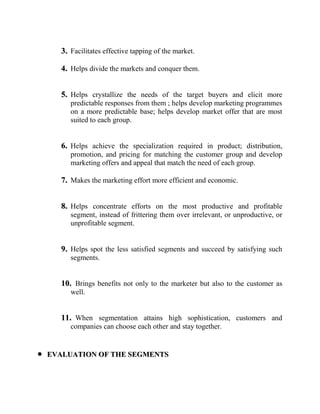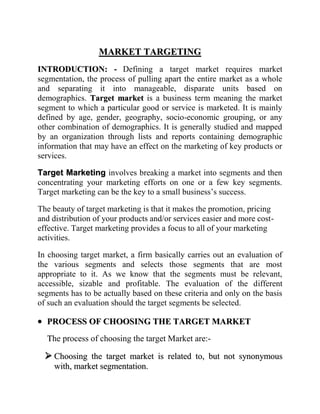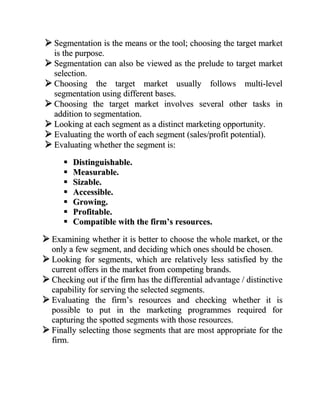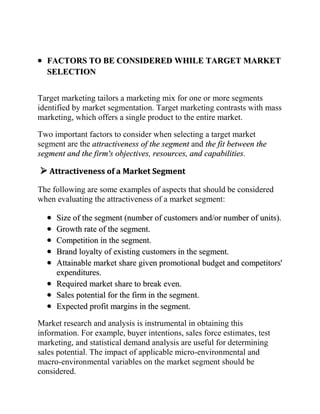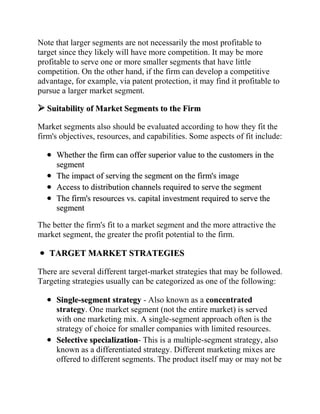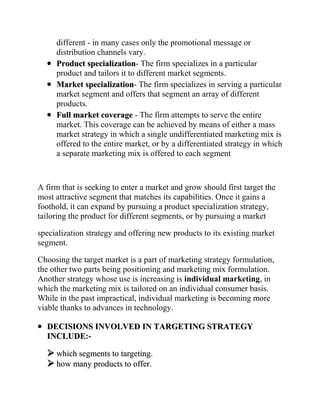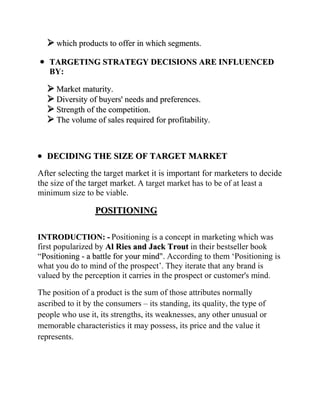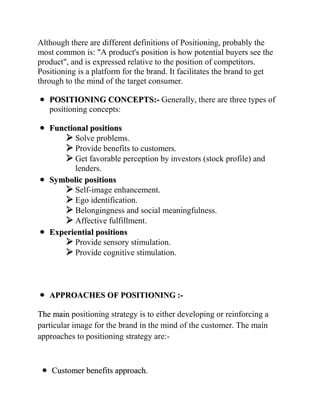Module 3 course1
- 1. Market segmentation A marketing term referring to the aggregating of prospective buyers into groups (segments) that have common needs and will respond similarly to a marketing action. Market segmentation enables companies to target different categories of consumers who perceive the full value of certain products and services differently from one another. Generally three criteria can be used to identify different market segments: 1) Homogeneity (common needs within segment) 2) Distinction (unique from other groups) 3) Reaction (similar response to market) In order to capture this heterogeneous market for any product, marketers usually divide or disintegrate the market into a number of sub-markets/segments and the process is known as market segmentation. Thus we can say that market segmentation is the segmentation of markets into homogenous groups of customers, each of them reacting differently to promotion, communication, pricing and other variables of the marketing mix. Market segments should be formed in that way that difference between buyers within each segment is as small as possible. Thus, every segment can be addressed with an individually targeted marketing mix. The importance of market segmentation results from the fact that the buyers of a product or a service are no homogenous group. Actually, every buyer has individual needs, preferences, resources and behaviors. Since it is virtually impossible to cater for every customer‟s individual characteristics, marketers group customers to market segments by variables they have in common. These common characteristics allow developing a standardized marketing mix for all customers in this segment. Through segmentation, the marketer can look at the differences among the customer groups and decide on appropriate strategies/offers for each group. This is precisely why some marketing gurus/experts have described segmentation as a strategy of dividing the markets for conquering them. MARKETING STRATEGY AND MARKET SEGMENTATION: - When it comes to marketing strategies, most people spontaneously think about the 4P (Product, Price, Place, Promotion) – maybe extended by three more Ps for marketing services (People, Processes, Physical Evidence).
- 2. Market segmentation and the identification of target markets, however, are an important element of each marketing strategy. They are the basis for determining any particular marketing mix. Basic steps in marketing strategy are as follows:- Market Segmentation 1.Identification of customers' needs and market segments. 2.Develop profiles of resulting market segments. Identification of Target Markets 3.Evaluation of attractivity of each segment. 4.Selection of target segments. Positioning 5. Identification of differential advantages in each segment. 6. Development and selection of positioning concepts. Marketing Planning 7. Development of a marketing mix for each segment according to the chosen position. ATTRIBUTES OF EFFECTIVE SEGMENTATION Market segmentation is resorted to for achieving certain practical purpose. For example, it has to be useful in developing and implementing effective and practical
- 3. marketing programmes. For this to happen, the segments arrived at must meet certain criteria such:- a. Identifiable: The differentiating attributes of the segments must be measurable so that they can be identified. b. Accessible: The segments must be reachable through communication and distribution channels. c. Sizeable: The segments should be sufficiently large to justify the resources required to target them. A very small segment may not serve commercial exploitation. d. Profitable: - There is no use in locating segments that are sizeable but not profitable. e. Unique needs: To justify separate offerings, the segments must respond differently to the different marketing mixes. f. Durable: The segments should be relatively stable to minimize the cost of frequent changes. g. Measurable: The potential of the segments as well as the effect of a specific marketing mix on them should be measurable. h. Compatible: - Segments must be compatible with firm‟s resources and capabilities. REASONS FOR MARKET SEGMENTATION Segmentation is the basis for developing targeted and effective marketing plans. Furthermore, analysis of market segments enables decisions about intensity of marketing activities in particular segments. A segment-orientated marketing approach generally offers a range of advantages for both, businesses and customers. 1. Facilitates proper choice of target marketing:- Segmentation helps the marketers to distinguish one customer group from another within a given market and thereby enables him to decide which segment should form his target market. 2. Higher Profits: - It is often difficult to increase prices for the whole market. Nevertheless, it is possible to develop premium segments in which customers accept a higher price level. Such segments could be distinguished from the mass market by features like
- 4. additional services, exclusive points of sale, product variations and the like. A typical segment-based price variation is by region. The generally higher price level in big cities is evidence for this. When differentiating prices by segments, organizations have to take care that there is no chance for cannibalization between high-priced products with high margins and budget offers in different segments. This risk is the higher, the less distinguished the segments are. 3. Facilitates tapping of the market, adapting the offer to the target:- Segmentation also enables the marketer to crystallize the needs of target buyers. It also helps him to generate an accurate prediction of the likely responses from each segment of the target buyer. Moreover, when buyers are handled after careful segmentation, the responses for each segment will be homogeneous. This in turn, will help the marketer develop marketing offer/programmers that most suited to each groups. He can achieve specialization that is required in product, distribution, promotion and pricing for matching the particular customer group and develop offers and appeals for the segmented group. Example of Ford: - Ford has gained useful insights through segmentation and adapted its offer to suit the Indian target market. For the Indian segment Ford made some changes in its cars in comparison to their European version. Modifications such as: - a. Higher ground clearance to make the car compatible to the rougher road surface in India. b. Stiffer rear springs to enable negotiating the ubiquitous potholes on Indian roads. c. Changes in cooling requirement, with greater airflow to the rear. d. Higher resistance to dust. e. Compatibility of engine with the quality of fuel available in India. f. Location of horn buttons on the steering wheel. As Indian motorists use horn far more frequently than the European where the horns are located on the lever.
- 5. 4. Stimulating Innovation: - An undifferentiated marketing strategy that targets at all customers in the total market necessarily reduces customers‟ preferences to the smallest common basis. Segmentations provide information about smaller units in the total market that share particular needs. Only the identification of these needs enables a planned development of new or improved products that better meet the wishes of these customer groups. If a product meets and exceeds a customer‟s expectations by adding superior value, the customers normally is willing to pay a higher price for that product. Thus, profit margins and profitability of the innovating organizations increase. 5. Makes the marketing effort more efficient and economic: - Segmentation ensures that the marketing effort is concentrated on well defined and carefully chosen segments. After all, the resources of any firm are limited and no firm can normally afford to attack and tap the entire market without any delimitation whatsoever. It would benefit the firm if the efforts were concentrated on segments that are more profitable and productive ones. Segmentation also helps the marketer assess as to what extend existing offer from competitors match the needs of different customer segments. The marketer can thus identify the relatively less satisfied segments and succeed by concentrating on them and satisfying their needs. 6. Benefits the customer as well: - Segmentation brings benefits not only to the marketer, but to the customer as well. When segmentation attains higher levels of sophistication and perfection, customers and companies can conveniently settle down with each other, as at such a stage, they can safely rely on each other‟s discrimination. The firm can anticipate the wants of the customers and the customers can anticipate the capabilities of the firm. 7. Sustainable customer relationships in all phases of customer life cycle: - Customers change their preferences and patterns of behavior over time. Organizations that serve different segments along a customer‟s life cycle can guide their customers from stage to stage by always offering them a special solution for their particular needs. For example, many car manufacturers offer a product range that caters for the needs of all phases of a customer life cycle: first car for early teens, fun-car for young professionals, family car for young families, etc. Skin care cosmetics brands often offer special series for babies, teens, normal skin, and elder skin.
- 6. 8. Targeted communication: - It is necessary to communicate in a segment-specific way even if product features and brand identity are identical in all market segments. Such a targeted communications allows to stress those criteria that are most relevant for each particular segment (e.g. price vs. reliability vs. prestige). 9. Higher market Shares: - In contrast to an undifferentiated marketing strategy, segmentation supports the development of niche strategies. Thus marketing activities can be targeted at highly attractive market segments in the beginning. Market leadership in selected segments improves the competitive position of the whole organization in its relationship with suppliers, channel partners and customers. It strengthens the brand and ensures profitability. On that basis, organizations have better chances to increase their market shares in the overall market. BASES FOR SEGMENTATION Markets can be segmented using several relevant bases. There are huge number of variables which leads to market segmentation. They comprise easy to determine demographic factors as well as variables on user behavior or customer preferences. Segmentation is done for consumer market and industrial market. Bases for segmentation in consumer market:- Consumer market can be segmented on the following customer characteristics 1. Geographic Segmentation. 2. Demographic Segmentation. 3. Psychographic Segmentation. 4. Behaviouralistic Segmentation. 1) Geographic Segmentation: - Potential customers are in a local, state, regional or national marketplace segment. If a firm selling a product such as farm equipment, geographic location will remain a major factor in segmenting your target markets since their customers are located in particular rural areas. While for retail store, geographic location of the store
- 7. is one of the most important considerations, in this case city areas are preferred. Segmentation of customers based on geographic factors are:- a. Region: - Segmentation by continent / country / state / district / city. b. Size: - Segmentation on the basis of size of a metropolitan area as per its population size. c. Population density: - Segmentation on the basis of population density such as urban / sub-urban / rural etc. d. Climate: - Segmentation as per climatic condition or weather. 2) Demographic Segmentation: - Segmentation of customers based on demographic factors are:- a. Age (dominant factor):-Segmentation is done on the basis of age of person. Example Titan has segmented its product according to different age group of person. Titan’s product segmentation on the bases of age:- Titan created a sub brand, Fastrack. These watches are specifically for young, vibrant, and cool outgoing young generation. While for older person and professional it has created the steel series watches and also the famous, Sonata. a. Income (dominant factor):-Segmentation is done on the basis of income level of a person. Example of Titan watches can be citied such as Titan offered Aurum and Royale in the gold/jewellery watch range with price ranges between Rs. 20000 to Rs.1 lakh.
- 8. For middle segment, Titan offered Exacta range in stainless steel, aimed at withstanding the rigours of daily life. There were 100 models in the range. Price ranges within Rs500-700. For the third segment, Titan offered the Sonata range. The price range was between Rs.350 to 500. b. Purchasing power (dominant factor):- Segmentation done on the basis of purchasing power of the customer. Examples of different car segment based on purchasing power are :- Budget car segment- It is the largest segment in Indian market. Here the entry level starts from Rs 1.5 to 3 lakh. Maruti 800 and Omni are the dominant players in these segments. With the launch of Tata Nano with a price range of 1lakh the outlook of this segment has changed. This segment is sometimes referred to as the small car segment. Competition in this segment is extreme in Indian market. Compact car segment- It lies between budget car and family car. Preferred price range is between Rs 3 to 4.5 lakh. Maruti Zen, Fiat Uno, Tata Indica, Santro, Matiz is some of the dominant players in this segment. Family car segment- The purchasing capacity of buyers of this segment is somewhat higher than that of the budget and compact car segment. Price ranges between Rs 4.5 to 6 lakhs. Maruti Esteem, Daewoo Cielo, and HM Contessa belongs to this segment. In India cars that are sold in India as „Budget Car‟ and „Compact Car‟ do not meet their purpose, especially in term of space, that they turn to „the family car segment‟.
- 9. Premium car segment- This segment represents the buyer who require true world class luxury car. Price ranges between Rs 6 to 8 lakh. Ford Escort, Honda City, Honda City, Mitsubishi Lancer, Audi 1800, Opel Astra etc are some of the major cars in this segment. Super luxury saloon segment- Buyer in this segment looks for a real super premium segment car. Mercedes Benz E229, E-250, Rover Montego, Audi 6, BMW are the players in this segment. Obviously, this is a tiny segment in the Indian context. c. Occupation. d. Gender (dominant factor):-Product can be segmented for male and female. e. Family Size. f. Family life cycle. g. Nationality. h. Religion. i. Education:-Primary, High School, Secondary, College, Universities. Many of these variables have standard categories for their values. For example family lifecycle often is expressed as bachelor, married with no children, full-nest, and empty-nest or solitary survivor. 3) Psychographic Segmentation: - Psychographic Segmentation groups customers according to their life-style and buying psychology. Many businesses offer products based on the attitudes, beliefs and emotions of their target market. The desire for status, enhanced appearance and more money are examples of psychographic variables. They are the factors that influence your customers' purchasing decision. A seller of luxury items would appeal to an individual's desire for status symbols Psychographic Segmentation includes variables such as:- a. Activities. b. Interests.
- 10. c. Opinions. d. Attitudes. e. Values. Activities, Interests, and Opinions (AIO) surveys are one tool of measuring lifestyle. 4) Behaviouralistic Segmentation: - Markets can be segmented on the basis of buyer behaviour as well. Since all Segmentation is in a way related to buyer behavior, one might be tempted to ask why buyer behavior-based segmentation should be a separate method. It is because there is some distinction between buyer‟s characteristics that are reflected by their geographic, demographic and psychographic profiles, and their buying behaviour. Marketers often find practical benefit in using buying behaviour as a separate segmentation base in addition to bases like geographic, demographics, and psychographics. The primary idea in buyer behaviour segmentation is that different customer groups expect different benefits from the same product and accordingly, they will be different in their motives in owing it and their behavior in buying it. Variables of buyer behavior are:- a. Benefit sought: - Quality / economy / service / look etc of the product. b. Usage rate: - Heavy user / moderate user / light user of a product. c. User status: - Regular / potential / first time user / irregular /occasional. d. Brand Loyalty: - Hard core loyal / split loyal / shifting / switches. e. Readiness to buy. f. Occasion: - Holidays and occasion stimulate customer to purchase products. g. Attitude toward offering: - Enthusiastic / positive attitude / negative attitude / indifferent / hostile.
- 11. Bases for segmentation in industrial market- In contrast to consumers, industrial customers tend to be fewer in number and purchase larger quantities. They evaluate offerings in more detail, and the decision process usually involves more than one person. These characteristics apply to organizations such as manufacturers and service providers, as well as resellers, governments, and institutions. Many of the consumer market segmentation variables can be applied to industrial markets. Industrial markets might be segmented on characteristics such as: 1. Location. 2. Company type. 3. Behavioral characteristics. 1) Location In industrial markets, customer location may be important in some cases. Shipping costs may be a purchase factor for vendor selection for products having a high bulk to value ratio, so distance from the vendor may be critical. In some industries firms tend to cluster together geographically and therefore may have similar needs within a region. 2) Company Type: Business customers can be classified according to type as follows : a. Company size:-Whether the company is a large scale industry / a small scale industry. Large industry always tries to order in bulk commodities while opposite for small scale sector. b. Industry: - Whether the industry is manufacturing industry / service industry. Also sometime differentiation is done between public sector industry or a private sector industry. c. Decision making unit. d. Purchase Criteria. 3) Behavioral Characteristics
- 12. In industrial markets, patterns of purchase behavior can be a basis for segmentation. Such behavioral characteristics may include: Usage rate Buying status: potential, first-time, regular, etc. Purchase procedure: sealed bids, negotiations, etc. Multi-level Segmentation: A Market can be segmented, using several bases in succession- While discussing about bases of segmentation we must discuss about multi-level segmentation, as it is not as through segmentation bases discussed above are mutually exclusive and a market can be segmented only with one particular base, on either / or basis. Since customer characteristic are spread over several variables, any market can be segmented through several bases. Different bases can be used in combination in segmenting a given market. They just have to be relevant for the concerned market. Actually, the different bases can be used in succession in a suitable order, and the market can be segmented at multi-levels. For example, a market can be segmented using the demographic base in the first instance, followed by the psychographic base and the buyer behavior/benefit base. Or, the market can be segmented using volume as the base in the first instance, followed by the demographic/psychographic/buyer behavior/benefit base. Assuming for example, that the firm first carries out volume segmentation of its market, it can know who the heavy user of its product are, but it cannot know the purpose for which they buy the product. The firm can then pick up the heavy users and carry out a multi-level segmentation, and continue its probe more deeply. Since each of these bases has several sub-bases, the numbers of levels in which a market can be segmented are indeed numerous. Actually, the aim should always be to go as deep as possible in segmenting the market so that segments that are most attractive and most suited can be chosen. Multi-level segmentation enables better selection of target market and better choice of marketing mix: Multi-level segmentation enables the marketers to choose his target market better. It also helps him to make the winning strategy and strike the right product offer and the right marketing mix. With the information generated from multi-level segmentation, he can obtain a deeper understanding of the customers in each segment, their needs, buying motives and buying behaviour.
- 13. He can understand in what way each of the different segments want the product to be, he can then tailor his product, marketing offer and promotional appeal, to fit the individual segment; he can select the priced, distribution method/channels, media vehicles, advertising massages and sales appeal, which will be appropriate. Example of General Motors:- GM has identified about 40 different „customer needs‟ and correspondingly, 40 different market segments in which it would present with its vehicles. For example, it has targeted the Pontiac at active, sports-oriented, young couples, the Chevrolet at price-conscious young families, the Oldsmobile at affluent families, and the Buick at older, more conservative couples. APPROACHES IN SEGMENTATION George Day (1980) describes models of segmentation as the top-down approach: In this approach “firms starts with the total population and divide it into segments”. He also identified an alternative model which he called the bottom-up approach. In this approach,” firms starts with a single customer and build on that profile”. This typically requires the use of customer relationship management software or a database of some kind. Profiles of existing customers are created and analysed. Various demographic, behavioural, and psychographic patterns are built up using techniques such as cluster analysis. This process is sometimes called database marketing or micro-marketing. Its use is most appropriate in highly fragmented markets. McKenna (1988) claims that this approach treats every customer as a "micro majority". Pine (1993) used the bottom-up approach in what he called "segment of one marketing". Through this process mass customization is possible. ADVANTAGES OF MARKET SEGMENTATION Various advantages of market segmentation are:- 1. Helps distinguish one customer group from another within a given market. 2. Facilitates proper choice of target market.
- 14. 3. Facilitates effective tapping of the market. 4. Helps divide the markets and conquer them. 5. Helps crystallize the needs of the target buyers and elicit more predictable responses from them ; helps develop marketing programmes on a more predictable base; helps develop market offer that are most suited to each group. 6. Helps achieve the specialization required in product; distribution, promotion, and pricing for matching the customer group and develop marketing offers and appeal that match the need of each group. 7. Makes the marketing effort more efficient and economic. 8. Helps concentrate efforts on the most productive and profitable segment, instead of frittering them over irrelevant, or unproductive, or unprofitable segment. 9. Helps spot the less satisfied segments and succeed by satisfying such segments. 10. Brings benefits not only to the marketer but also to the customer as well. 11. When segmentation attains high sophistication, customers and companies can choose each other and stay together. EVALUATION OF THE SEGMENTS
- 15. Whether market segmentation is successful or not can be evaluated by the following questions- 1. Is it sizeable: - Size-wise, the popular segment is a bigger compared to the premium segment. In term of tonnage, of the total market of around 6, 00,000 tonnes, the popular segment account for 80 percent and the premium segment for the remaining 20 percent. If the firm wants a very large volume, it has to think of the popular segment. At the same time, it has to note that the premium segment too is sizeable, as it account for over 120,000 tonnes. In term of value, the premium segment is even more sizeable, formerly nearly 30 percent of the total market. Clearly, the segment cannot be ruled out as lacking in size. 2. Is it growing: - Growth rate and likely future position of the segment will be the next consideration in the evaluation process. Usually, business firms seek out the high growth segments. Analysis will readily indicate to the firm that in bath soaps, the premium segment happens to be the high growth segment. Whereas the popular segment has been growing at 10 percent per annum, the premium segment has been growing at over 20 percent annum. When this fact is taken into consideration, the firm‟s choice may tilt toward the premium segment. The tilt will be particularly pronounced if the firm‟s natural disposition is to strive for a position in the high growth segment of the business. 3. Is it profitable: - Next consideration will be the extend of profitability. In the present example, the firms quickly sense that the premium segment is more profitable one. Even a relatively lower volume in the segment may bring in good returns. On the contrary, in the popular segment, a much larger volume will be necessary for the business to be viable, since prices and margins in the segment are low.
- 16. Another point is that costs of marketing, distribution and promotion in the business are quite high and are constantly on the rise. Costs of launching a new brand are particularly high. The market is very competitive, aggressive promotional support through expensive media like TV becomes essential. In this background, the firm may come to the conclusion that it may be worthwhile to gamble in the premium segment rather than the popular segment. 4. Is it accessible: - The firm has to now consider whether the segments are accessible to it. This may need further analysis. The market realities will have to be taken into consideration. The popular segment will be accessible only to the firm with a cost advantage, since price is a major determinant in this segment. Premium segment will be accessible only to firms, which enjoy a differentiation advantage, and which are also marketing savvy. Liril of Hindustan Lever has a commanding position in this segment. At the upper end of the segment, HLL‟s Pears and Dove are well entrenched. Several other brands of different companies are competing in the segment. The firm has to take due note of this reality. At the same time, analysis also reveals that new brands do keep entering the segment every now and then, and some of them do manage to stay. So, the firm has no reason to believe that the premium segment is not accessible to it, unless it is convinced that it is very weak in marketing. 5. Is it compatible with the firm’s resources and capabilities: - Having reached the conclusion that the premium segment is sizeable, growth oriented, profitable and accessible, the firm has to now find out if the segment matches its resources. For some firms, the popular segment may be the natural choice and for others, the premium segment. And, for some other choosing both. The premium segment is a highly competitive segment. Only firms endowed with strong resources and an aggressive marketing strategy/culture can fight and survive in the market. The firm therefore has to assess whether the particular segments are compatible with its resources and capabilities.
- 17. MARKET TARGETING INTRODUCTION: - Defining a target market requires market segmentation, the process of pulling apart the entire market as a whole and separating it into manageable, disparate units based on demographics. Target market is a business term meaning the market segment to which a particular good or service is marketed. It is mainly defined by age, gender, geography, socio-economic grouping, or any other combination of demographics. It is generally studied and mapped by an organization through lists and reports containing demographic information that may have an effect on the marketing of key products or services. Target Marketing involves breaking a market into segments and then concentrating your marketing efforts on one or a few key segments. Target marketing can be the key to a small business‟s success. The beauty of target marketing is that it makes the promotion, pricing and distribution of your products and/or services easier and more cost- effective. Target marketing provides a focus to all of your marketing activities. In choosing target market, a firm basically carries out an evaluation of the various segments and selects those segments that are most appropriate to it. As we know that the segments must be relevant, accessible, sizable and profitable. The evaluation of the different segments has to be actually based on these criteria and only on the basis of such an evaluation should the target segments be selected. PROCESS OF CHOOSING THE TARGET MARKET The process of choosing the target Market are:- Choosing the target market is related to, but not synonymous with, market segmentation.
- 18. Segmentation is the means or the tool; choosing the target market is the purpose. Segmentation can also be viewed as the prelude to target market selection. Choosing the target market usually follows multi-level segmentation using different bases. Choosing the target market involves several other tasks in addition to segmentation. Looking at each segment as a distinct marketing opportunity. Evaluating the worth of each segment (sales/profit potential). Evaluating whether the segment is: Distinguishable. Measurable. Sizable. Accessible. Growing. Profitable. Compatible with the firm’s resources. Examining whether it is better to choose the whole market, or the only a few segment, and deciding which ones should be chosen. Looking for segments, which are relatively less satisfied by the current offers in the market from competing brands. Checking out if the firm has the differential advantage / distinctive capability for serving the selected segments. Evaluating the firm‟s resources and checking whether it is possible to put in the marketing programmes required for capturing the spotted segments with those resources. Finally selecting those segments that are most appropriate for the firm.
- 19. FACTORS TO BE CONSIDERED WHILE TARGET MARKET SELECTION Target marketing tailors a marketing mix for one or more segments identified by market segmentation. Target marketing contrasts with mass marketing, which offers a single product to the entire market. Two important factors to consider when selecting a target market segment are the attractiveness of the segment and the fit between the segment and the firm's objectives, resources, and capabilities. Attractiveness of a Market Segment The following are some examples of aspects that should be considered when evaluating the attractiveness of a market segment: Size of the segment (number of customers and/or number of units). Growth rate of the segment. Competition in the segment. Brand loyalty of existing customers in the segment. Attainable market share given promotional budget and competitors' expenditures. Required market share to break even. Sales potential for the firm in the segment. Expected profit margins in the segment. Market research and analysis is instrumental in obtaining this information. For example, buyer intentions, sales force estimates, test marketing, and statistical demand analysis are useful for determining sales potential. The impact of applicable micro-environmental and macro-environmental variables on the market segment should be considered.
- 20. Note that larger segments are not necessarily the most profitable to target since they likely will have more competition. It may be more profitable to serve one or more smaller segments that have little competition. On the other hand, if the firm can develop a competitive advantage, for example, via patent protection, it may find it profitable to pursue a larger market segment. Suitability of Market Segments to the Firm Market segments also should be evaluated according to how they fit the firm's objectives, resources, and capabilities. Some aspects of fit include: Whether the firm can offer superior value to the customers in the segment The impact of serving the segment on the firm's image Access to distribution channels required to serve the segment The firm's resources vs. capital investment required to serve the segment The better the firm's fit to a market segment and the more attractive the market segment, the greater the profit potential to the firm. TARGET MARKET STRATEGIES There are several different target-market strategies that may be followed. Targeting strategies usually can be categorized as one of the following: Single-segment strategy - Also known as a concentrated strategy. One market segment (not the entire market) is served with one marketing mix. A single-segment approach often is the strategy of choice for smaller companies with limited resources. Selective specialization- This is a multiple-segment strategy, also known as a differentiated strategy. Different marketing mixes are offered to different segments. The product itself may or may not be
- 21. different - in many cases only the promotional message or distribution channels vary. Product specialization- The firm specializes in a particular product and tailors it to different market segments. Market specialization- The firm specializes in serving a particular market segment and offers that segment an array of different products. Full market coverage - The firm attempts to serve the entire market. This coverage can be achieved by means of either a mass market strategy in which a single undifferentiated marketing mix is offered to the entire market, or by a differentiated strategy in which a separate marketing mix is offered to each segment A firm that is seeking to enter a market and grow should first target the most attractive segment that matches its capabilities. Once it gains a foothold, it can expand by pursuing a product specialization strategy, tailoring the product for different segments, or by pursuing a market specialization strategy and offering new products to its existing market segment. Choosing the target market is a part of marketing strategy formulation, the other two parts being positioning and marketing mix formulation. Another strategy whose use is increasing is individual marketing, in which the marketing mix is tailored on an individual consumer basis. While in the past impractical, individual marketing is becoming more viable thanks to advances in technology. DECISIONS INVOLVED IN TARGETING STRATEGY INCLUDE:- which segments to targeting. how many products to offer.
- 22. which products to offer in which segments. TARGETING STRATEGY DECISIONS ARE INFLUENCED BY: Market maturity. Diversity of buyers' needs and preferences. Strength of the competition. The volume of sales required for profitability. DECIDING THE SIZE OF TARGET MARKET After selecting the target market it is important for marketers to decide the size of the target market. A target market has to be of at least a minimum size to be viable. POSITIONING INTRODUCTION: - Positioning is a concept in marketing which was first popularized by Al Ries and Jack Trout in their bestseller book “Positioning - a battle for your mind". According to them „Positioning is what you do to mind of the prospect‟. They iterate that any brand is valued by the perception it carries in the prospect or customer's mind. The position of a product is the sum of those attributes normally ascribed to it by the consumers – its standing, its quality, the type of people who use it, its strengths, its weaknesses, any other unusual or memorable characteristics it may possess, its price and the value it represents.
- 23. Although there are different definitions of Positioning, probably the most common is: "A product's position is how potential buyers see the product", and is expressed relative to the position of competitors. Positioning is a platform for the brand. It facilitates the brand to get through to the mind of the target consumer. POSITIONING CONCEPTS:- Generally, there are three types of positioning concepts: Functional positions Solve problems. Provide benefits to customers. Get favorable perception by investors (stock profile) and lenders. Symbolic positions Self-image enhancement. Ego identification. Belongingness and social meaningfulness. Affective fulfillment. Experiential positions Provide sensory stimulation. Provide cognitive stimulation. APPROACHES OF POSITIONING :- The main positioning strategy is to either developing or reinforcing a particular image for the brand in the mind of the customer. The main approaches to positioning strategy are:- Customer benefits approach.
- 24. The price-quality approach. The use or application approach. The product user approach. The product class approach. The cultural symbol approach. The competitor approach. 1. Customer benefit approach: - This is an important positioning strategy. It involves putting the brand above competitors, based on specific brand attributes and customer benefit. In the automobiles sector we can see many car manufacturer give emphasis on different technical aspects such as fuel efficiency, safety, engine performance, power windows etc. Generally marketers identify positioning in respect of product characteristics that have been ignored by the competitor. Often we can see that firms attempts to position their brands along with two or more characteristic simultaneously, this is done to give an extra edge to the product from its rival and also helps increase the product‟s life cycle. Thus a single product can solve many problem is the main theme behind the product. Example: Procter & Gamble’s Head & shoulder shampoo functions as anti dandruff and anti hairfall shampoo. Price quality approach: - Sometimes brands attempts to offer more in term of service, feature, quality, or performance. Manufacturer of such brands
- 25. charge higher prices partly to cover the cost and partly to communicate the fact that they are of high quality. 2. The use and application approach: - In this strategy the product is positioned with a use or application approach. For example: - Largest Mobile manufacturer in the world Nokia positioned its few variant of N-series mobiles as music phones with enhanced memory and multimedia capabilities. 3. The product user approach:- In this approach, the brand identifies and determines the target segement for which the product will be positioned. Many brand uses a model or a celebrity to position their product. The expectation are that a model or a celebrity is likely to influence the product‟s image by reflecting their own image to it. For example:- Dabur Chyvanprash is positioned for all age groups. 4. The product class approach:- This approach is use so that the brand is associated with a particular product category. This is generally used when a category is too crowded. For example:- HLL has positioned Dove toilet soap as a cleansing cream product for young womwn with dry skin and its is positioned as a premium segment toilet soap. 5. The cultural symbol approach:- The positioning strategy is based on deeply entrenched cultural symbol. The use of cultural symbol can help to differentiate the brand from competitors brands. For example:- The positioning technique of Marlboro cigarettes use the image of typical American cowboy . 6. The competitor approach:- Many brands use competitor as a dominant plank in their campaign. These brands are positioned following its competitor. This is an offensive strategy.
- 26. DIFFERENT POSITIONING PLANKS / BASES:- Different types of positioning planks /bases are used by the marketers are:- 1. Economy:- Product positioned toward a particular segment keeping in mind it economy.Example-Maruti 800, Tata Nano, Nirma detergent powder etc are positioned for the economy segment 2. Benefit:- Product positioned with some beneficial features. Example-Colgate total, Clinic plus etc. 3. Gender:- Product positioned for a particular segment. Example- Scooty Pep, Titan Raga. 4. Luxury and exclusiveness:- Product or services positioned toward luxury segment. Example-Taj group of hotel, Mercedes Benz E- class etc. Fashion for elite class:- Product positioned for fashionable elite class or member of the society, who always want to stay ahead in term of fashion and demands exclusive products only. Example Peter England, Van Heusen, Raymond etc. 5. Technology and value added features:- Positioning of a product according to its technological advancement and value added features. Example:- Microsoft’s positioning of its recent operating system Windows Vista as the advanced operating system, Sony with various elecronic goods, LG etc
- 27. POSITIONING PLANNING Positions are described by variables and within parameters that are important to the customers. Common examples are price, supporting services, quality, reliability, and value for money. Often, customers position a product in relation to a brand or product that is especially visible to them. This could be the market leader or any other offer with a high media exposure and an above average marketing budget. Therefore, it is advisable to use in-depth market research to determine relevant parameters in order to understand how customers rate different products and marketing variables. The number of relevant parameters is normally low. Most often, they can be described with a two- or three-dimensional matrix. This tool to visually depict customers‟ perceptions of a product and its position is called perceptual mapping. Normally, most suppliers in a market or in a market segment will be positioned along the diagonal. This diagonal is called the Value- Equivalence-Line (VEL), since value and price are balanced there. In our example, product A is positioned unfavourably. It is too expensive for the mass market and its quality is not good enough for the premium segment. In general, there are the following strategies for repositioning; however, their feasibility will depend on the particular situation. Change the relation of price and quality for the existing brand; e.g. product relaunch with improved characteristics
- 28. Change the relation of price and quality by introducing a new brand; e.g. introduction of clone under a „cheap‟ brand or a retailers own brand Alter believes about the brand; e.g. image campaign, creation of a „hype‟ Alter believes about competitive brands; e.g. comparing advertisements Alter customers‟ rankings of important factors; e.g. focus on additional features and characteristics (example: car manufacturers focus on very different product characteristics in their commercials, for instance security, fuel consumption, image, luxury interior, fun) Introduction of new or neglected attributes; e.g. product relaunch with new features that are new for the whole market segment. When planning such activities it is critical to think about possible reactions of competitors. A shift of a product into a more favourable position in the price-quality-map above the diagonal (e.g. into position B) will normally lead to in shift of market shares in favour of this product. Competitors could react with a reduction of general price level, thus moving the VEL to the left. Product B would lose its superior position. Moreover, it is advisable to keep in mind that customer and their individual preferences of a price-quality-combination are not distributed equally along the VEL. Neglecting the distribution of customers could lead to the following problems:
- 29. Positioning in a segment with very few potential customers (e.g. positioning in a middle-segment in a market where customers prefer either the budget-product or the premium product) Positioning in a too low or too high price-value-combination (segments a and b in our example). This product does not appeal to a large proportion of the market, since customers either expect a higher quality (a) or are not willing to pay that high price. STEPS FOR POSITIONING A PRODUCT Dibb et al recommend the following steps for determining and implementing the positioning of a product. Although they focus on new product development, these steps are applicable to a relaunch with new features or for a repositioning of an existing product too. 1. Define the segments in a particular market. 2. Decide which segments to target. 3. Understand what the target consumers expect and believe to be the most important considerations when deciding on the purchase. 4. Develop a product (or products) that cater specifically for these needs and expectations. 5. Evaluate the positioning and images, as perceived by the target customers, of competing products in the selected market segments.
- 30. 6. Evaluate the market leader‟s position; leading brand that occupies a special position in the consumer„s mind (cadbury’s in chocolates); other brands have to necessary relate themselves in some wayto the leaders position; they cannot ignore the position of the leader, nor wish it away. 7. Select an image that sets the product apart from the competing products, thus ensuring that the chosen image matches the aspirations of the target customers. 8. Inform target customers about the product (promotion). PRODUCT POSITIONING AND BRAND POSITIONING It is essential to understand the relationship between product positioning and brand positioning. The two terms are synonymously and interchangeably used, technically they are different. Product positioning denotes the specific product category / product class in which the given product is opting to compete. And brand positioning denotes the positioning of the brand viz-a-viz the competing brands in the chosen product category. CRITERIA’S FOR SUCCESSFUL POSITIONING Certain criteria are needed to be fulfilled for successful positioning are:- a. Clarity: - While positioning its brand the firm must be able to position itself in both distinct value, proposition, and to its target audience. b. Consistency: - Consistency in positioning means keeping the positioning plank/bases intact for longtime. Planks should be carefully chosen while positioning. But it does not mean that the firm
- 31. must change its positioning bases even though its survival is at stake. The firm must be flexible to the changing environment. c. Credibility: - The firm must deliver trustworthy and believable value proposition. There should be perfect match between promise and action. d. Competitiveness: - For surviving in this competitive and changing environment innovative resources, talent pool, competitive advantage, strong financial backup etc are very important. REPOSITIONING Repositioning involves changing target market or distinct positioning claim/differences advantages or both to bring the saturated attention of the existing customers back into the limelight once again to survive safely and happily in the market. In some cases , the products that are faring well are repositioned. This is done mainly to enlarge the reach of the product offer and to increase the sale of the product by appealing to a wider target market. The product is provided with some new features or it is associated with some new uses and is repositioned for existing as well as new target market. Example of Maruti Omni repositioning can be citied as important case in repositioning strategy. When Maruti Omni was launched it was positioned as the low priced, spacious van. But in the market as the time passed, Maruti Omni cannot acquire a dominant position. The major competing brands are more spacious, though higher priced. Thus Maruti decided to take the path of repositioning. The features that were after repositioning are:- 1. Most cars do not have any fifth door in the car. Maruti Omni had the boot-latch at the back of the car which can be used both for entering and also for keeping goods. 2. In the new car there is around 7.5 cubic meter of space. This gives the advantage of more space for luggage and more people.
- 32. 3. For having a pleasant driving experience Maruti Omni the instrument panel is sleek, the steering columns just positioned just right, seat are adjustable with control lever and gear shaft at hand-touch distance. 4. Engine was improved from the previous one. It is more fuel efficient and delivers higher performance. 5. Safety features are standard. 6. A coolant system that eliminates daily chores of filling water in the radiator was introduced. .






